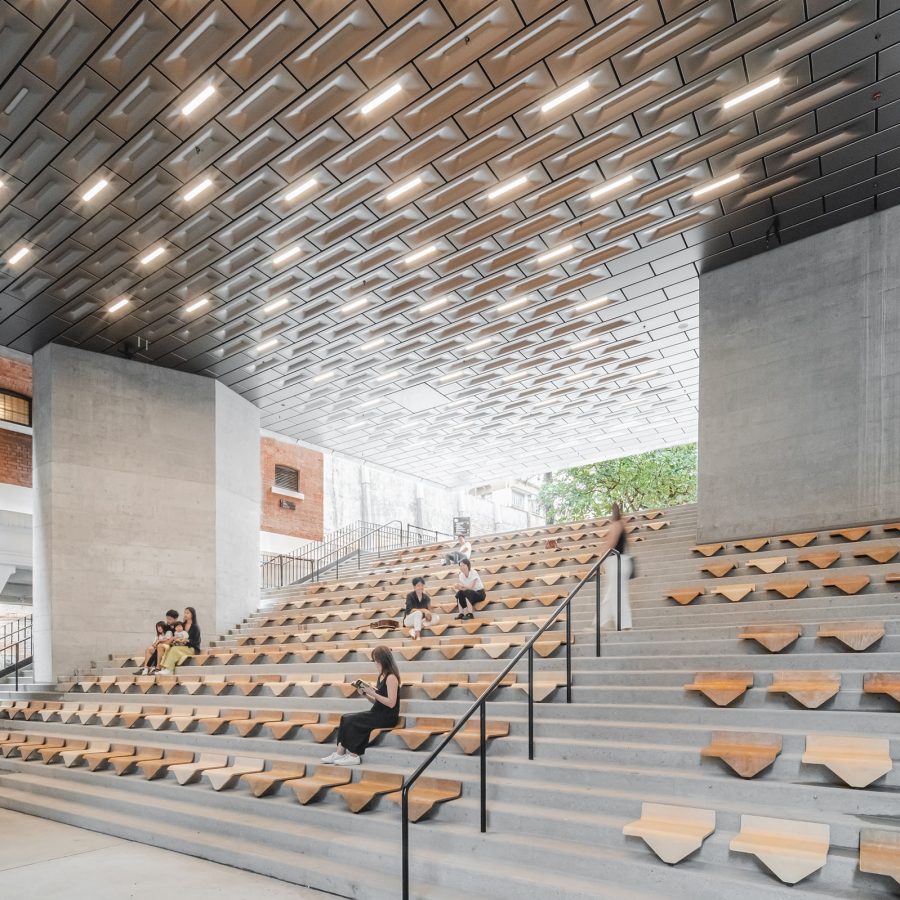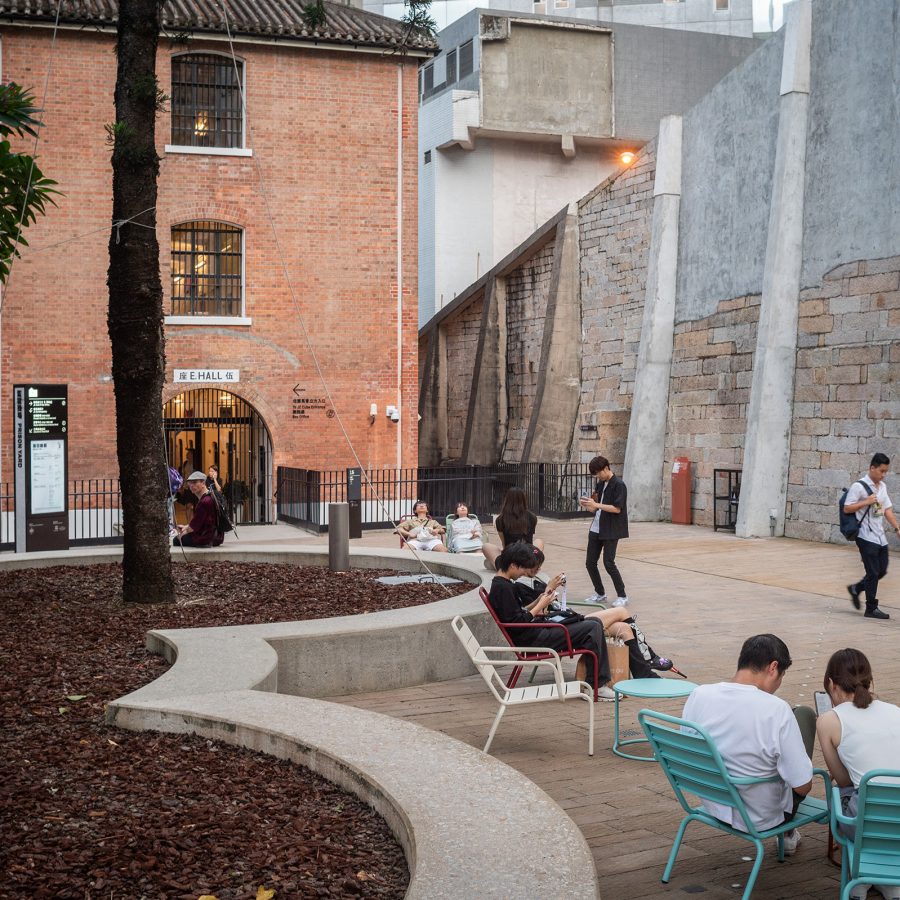Tai Kwun: Hong Kong's incredible art heritage experience

When you leave the frenetic streets of Central and enter the Tai Kwun Centre for Heritage and Arts, the first thing that hits you is the space: sprawling courtyards, mystery alleys, a rare openness amid the urban forest. Then, the architecture commands your attention: historic buildings juxtaposed against hypnotic modernity.
You become aware of the silence, the simple rustling of a majestic 60-year-old mango tree and the absence of taxi horns – very un-Central indeed, yet altogether welcome. The overwhelming feeling, though, is that this has been worth the wait.
After a decade of planning, construction and renovation, Hong Kong’s Central Police Station compound finally opened in 2018, encouraging visitors to question everything they think they know about the district and the city’s art scene.
A storied history
Named for a Cantonese colloquialism meaning “big station”, Tai Kwun is a collection of 16 heritage buildings, along with two huge courtyards, reimagined as spaces for art and performance. The compound includes Central Police Station, Central Magistracy and Victoria Prison, where Ho Chi Minh was incarcerated in the 1930s. Two dramatic aluminium-clad additions by Swiss architects Herzog & de Meuron house an art gallery and a performance venue. Named after the sites where felons formerly exercised and police performed their drills, The Prison Yard and Parade Ground are now relaxed open spaces for exhibitions, performances and sunny-day strolls.
The sheer scale of the site is unprecedented in a city that levelled many of its pre-war buildings decades ago. But that it’s in the prestigious Central district, where skyscrapers jostle against each other for a slice of some of the most expensive real estate on Earth, makes it a marvel.

Credit: Tai Kwun

Credit: Tai Kwun
“Most people didn’t even realise Hong Kong had this kind of big space,” says Eddy Zee, the former head of performing arts at Tai Kwun. “The public couldn’t ever go into the police station or into the courtyard to see the site. And suddenly we have this valuable space here. It touched me.”
Bridging past and present
After Central Police Station was decommissioned in 2006, the government and the Hong Kong Jockey Club (which operates gaming in the city and includes a huge charity trust) launched a joint not-for-profit arts venture to save the compound from the wrecking ball. A plan by Herzog & de Meuron and conservation architects Purcell was approved, and construction began in 2012. The opening was delayed by two years when a wall and roof collapsed during construction work in 2016, and the initial budget of HK$1.8 billion later swelled to HK$3.6 billion, prompting observers to question what was unravelling behind closed doors.

Credit: Tai Kwun
“It’s always been a highly challenging and highly sensitive project because this is the largest heritage project ever in Hong Kong and it’s stuck in the middle of a very old neighbourhood,” says Winnie Yeung, Tai Kwun’s former head of heritage. “It’s extremely difficult for people to understand a project like this with so many different facets. There’s heritage, there’s art, there’s leisure.”
One solution was to engage the community with an exhibition called 100 Faces of Tai Kwun. It was a chance to discuss the conservation and revitalisation project with the public while also featuring the stories of individuals who had memories of the compound: ex-officers, ex-offenders, nearby residents and individuals who had shown interest in the site, including photographers, journalists and architects.
“It’s exciting that someone might come to Tai Kwun with the idea of having a heritage experience, learning something about the history of law and order or architecture, and they get distracted by a performance on the laundry steps or drawn into the magnificent galleries and captivated by an exhibition,” says Timothy Calnin, director of Tai Kwun Arts. “These are the exciting opportunities for me – distracting people from their original purpose.”

Credit: Elvis Chung
A new era for contemporary art
Tai Kwun Contemporary is the complex’s contemporary art arm, which covers over 16,000 square feet of exhibition space within the new JC Contemporary building and the F Hall heritage building. It kicked off with Dismantling the Scaffold, a collaboration by artists from Hong Kong and beyond, and Six-Part Practice, an exhibition of minimalist sculptures made from Chinese medicine by local artist Wing Po So. Equipped with a 200-seat auditorium, JC Cube, which was formerly a laundry yard, was built alongside JC Contemporary to address modern needs.
Tai Kwun Contemporary is not bound to a collecting institution and is not commercial. “This means we can be a little more forward-thinking, a little more experimental,” says Tobias Berger, Tai Kwun’s former head of arts. “We can show art that is not so much in the local big galleries and local art sales. We all know the local art market has exploded in the last five to 10 years. What is missing at the moment is this medium-sized contemporary art space, and that is exactly what we have built here.”
Claire Hsu, co-founder and former executive director of Hong Kong-based nonprofit Asia Art Archive , agrees. “Hong Kong finally has a medium-sized kunsthalle for contemporary art, which will fill a gap within the arts ecology,” she says. “And while the arts ecology has grown tremendously over the years, it’s still very much geared towards the commercial, so an independent, sizeable art exhibition programme in the city is well overdue.”
Tai Kwun Contemporary works on a collaborative model, inviting local and international non-profits to stage exhibitions alongside them. “It’s very important that [our exhibitions] are all made for Hong Kong – we’re not a pitstop for travelling exhibitions,” says Berger. “Everything we do and everything we think about is from a Hong Kong point of view and with the local audience in mind.”

Credit: Tenants Tai Kwun

Credit: Tenants Tai Kwun
An inclusive cultural hub
The non-commercial attractions at Tai Kwun are propped up by 34 tenants, including restaurants, bars and design stores. Highlights include Madame Fu , an 8,000-square-foot Cantonese restaurant and lounge bar by local nightlife impresario Christian Rhomberg; Dragonfly , a bar paying homage to stained-glass artist Louis Tiffany; as well as 1862 bar de tapas y vino , a lively tapas bar offering delicious bites and a wide array of libations.
Berger recalls that a decade ago he was often arguing with people against the notion that Hong Kong was a cultural wasteland for the arts. “But compared to now, it was,” he says. “Tai Kwun is the most exciting project for heritage and also for art in Hong Kong for a long while.”
Mimi Brown, the founder of Spring Workshop, a non-profit art space that ran for five years from 2012, says Tai Kwun has the potential to amplify the wave of interest in contemporary art that Hong Kong is currently experiencing – as long as the focus remains in the right place.

Credit: Tai Kwun
“Tai Kwun is an enormous platform and has the ability to reach different swathes of the city that our many wonderful smaller arts organisations cannot,” she says. “Tai Kwun carries a big responsibility to lead the way in presenting the best cultural programming possible to diverse parts of the city’s population.”
“If it succeeds, it will be a huge boon to the city and will create cultural momentum that will continue to build with the opening of M+ and reopening of the Hong Kong Museum of Art. Ideally, these new large art spaces will not just be the first place that tourists head upon landing but also places that Hongkongers put on their agendas every month. That would be a watershed for our entire city.” And succeed it certainly has. In 2019, one year after opening, Tai Kwun received the Award of Excellence in the Unesco Asia-Pacific Awards for Cultural Heritage Conservation.
This story was accurate at the time of publishing in July 2018. Links and videos were updated in September 2025.
More inspiration
Hong Kong travel information
- China – the Chinese Mainland, Hong Kong SAR, Macao SAR and Taiwan Region
- Hong Kong SAR - English
- Chinese Mainland (China) - English
- Taiwan, China - English
- 香港特別行政區 - 繁體中文
- 中国內地 - 简体中文
- 中國台灣 - 繁體中文
- Africa
- South Africa - English
- Asia
- Bangladesh - English
- Korea - English
- Singapore - English
- Cambodia - English
- 한국 - 한국어
- Sri Lanka - English
- India - English
- Malaysia - English
- Thailand - English
- Indonesia - English
- Maldives - English
- ประเทศไทย - ภาษาไทย
- Indonesia - Bahasa Indonesia
- Myanmar - English
- Vietnam - English
- Japan - English
- Nepal - English
- Việt Nam - tiếng Việt
- 日本 - 日本語
- Philippines - English
- Australasia
- Australia - English
- New Zealand - English